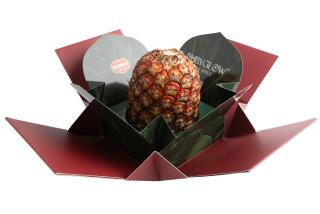Pineapple Firms in Hawaii Bounce Back From Slump
- Share via
HALIIMAILE, Maui — At Maui Pineapple Co.’s Haliimaile Plantation on the lush, green northern slopes of 10,023-foot Haleakala Crater, 500 field workers have been busy all summer harvesting 800 to 1,000 tons of pineapples a day. Hundreds more workers harvest the same amount at the company’s Kapalua Plantation overlooking picturesque Kapalua Bay on the island’s northwest slopes.
They are evidence that, contrary to observers’ fears in the 1970s, pineapples are far from being a dying industry in Hawaii. Last year’s $249.5-million harvest was a record for the islands’ three pineapple companies--Dole, Del Monte and Maui Pineapple. A dozen years ago, the value of the crop was $130 million.
Hawaii’s pineapple industry has been threatened by competition in the Philippines, Thailand and other Third World nations, where labor is much cheaper. Since 1980, the total Hawaiian acreage devoted to the crop has fallen to 35,000 from 43,000. The number of pineapple companies in the islands has shrunk to three from 11 in the 1940s.
To be sure, Hawaii’s growers do much of their own work overseas in those cheap-labor nations. However, to make their Hawaiian operations more competitive, they are spending millions of dollars to install labor-saving, state-of-the-art growing, harvesting and canning equipment.
“We’re not winding down. We’re building up. We’re optimistic about the future of Hawaiian pineapple,” said Joe Hartley, Maui Pineapple’s president. “Last year was the most profitable year in our history--$12.7 million in earnings on revenues of $74 million.”
Maui Pineapple’s profits have risen steadily for the last 12 years. “We are meeting and beating the competition from the Philippines and other Third World pineapple-producing areas, even though our field workers receive $8 an hour--$64 a day--while workers in the Philippines are paid only $3 a day,” Hartley said.
He acknowledged that the company had to struggle to survive during the late 1960s and early 1970s, when several pineapple companies in Hawaii went under.
Maui Pineapple, a subsidiary of Maui Land & Pineapple Co., is the world’s largest supplier of private-label canned pineapple, supplying chunks, slices and juice to 298 retailers in America, 90% of the U.S. private-label pineapple market. Colin C. Cameron, a sixth-generation Hawaiian descendant of New England missionaries, owns 42.8% of the parent company.
Established in 1909, Maui Pineapple has 8,000 acres of the golden fruit on the island of Maui. The pineapples are processed in the firm’s large cannery at the port town of Kahului, from which they’re shipped to the mainland.
At the Haliimaile Plantation one day recently, six workers were operating a $500,000, 35-foot-long, 15-foot-high pineapple planter perfected by company engineers to plant 75,000 pineapples. Four workers seated behind hoppers on the back of the machine fed pineapple tops, which start the new plants, into perforated holes on mulch strips automatically inserted into the ground.
Nearby, a dozen workers walked behind a 52-foot-long conveyor belt pulled by a tractor at one mile per hour. The workers, dressed in protective goggles, heavy aprons and gloves, picked the ripe fruit and placed it onto the conveyor belt.
“How do we compete?” mused Hartley. “We stay on top of everything.” New additions this year include a $350,000 research lab and a $200,000 computer system that tracks canned pineapple inventory through the company’s four warehouses.
Purchased Lanai Island
In 1901, James Dole founded the company that bears his name, now a division of Castle & Cooke Inc. Two years later, he opened Hawaii’s first successful pineapple cannery. In 1922, he purchased 18-mile-long, 13-mile-wide, kidney-shaped Lanai Island for $1.1 million and converted it into the world’s largest pineapple plantation.
Today Dole grows pineapples on 13,000 acres of Lanai and 7,000 acres on Oahu, where it also processes the fruit in a 60-year-old antiquated cannery.
Last month, David Murdock, the new chief executive and major stockholder of Castle & Cooke, announced plans to spend $50 million on a new cannery in central Oahu and a new concentration plant on Lanai. “We are committed to build the most modern and efficient processing facilities in the world in Hawaii,” said Murdock, who said he is also developing a master plan for 90,500-acre Lanai island that will include two hotels.
Murdock, saying he had been approached about locating it in another country, has asked the state of Hawaii to move fast on granting proper zoning for his cannery.
Dole and the other Hawaiian companies have extensive foreign operations. Less than 40% of Dole’s pineapple comes from Hawaii. The firm has had plantations in the Philippines since the early 1960s and in Thailand since the early 1970s.
Del Monte, which has been in the pineapple business in Hawaii since 1916, closed its pineapple cannery on Oahu three years ago. The pineapples harvested on the company’s 6,000 acres on Oahu and 1,500 acres on Molokai are strictly for the fresh market.
But, says Frank Dillard, vice president in charge of Hawaiian operations, “We have no intention of abandoning Hawaii. Our fresh market is a growing business.” The company has, however, reduced the number of employees in the islands by half since the cannery closed in 1983. It will not release precise figures.
Del Monte now does all its canning for the mainland U.S. market at its 60-year-old Philippines operation.
More to Read
Inside the business of entertainment
The Wide Shot brings you news, analysis and insights on everything from streaming wars to production — and what it all means for the future.
You may occasionally receive promotional content from the Los Angeles Times.










